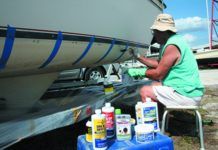Hurricane Preparation
My boat was lost in a recent bout with Hurricane Frances. My mooring had just been completely rebuilt from the bottom up. Two 5/8″ mooring pendnants held the boat to a 5/8″ chain assembly through an 18″ buoy with swivels to the bottom where a 6-foot-square by 1-foot-thick concrete block sits mired in the bottom. The boat was equipped with 8″ bow cleats properly mounted with backing plates as well as a 3/4″ line wrapping the boat along one side to the other using winches and stern cleats to form a “sling” should the cleats pull free. This line was secured to the mooring pendants. All was constructed with first-class methods and materials.
Somehow, my boat broke free and ended up in a wild, wind-blown ride across Sarasota Bay in the wee hours. That culminated in a 10-hour, bone-crushing execution with a concrete seawall. This broke her back and smashed the entire starboard side.
The salvage will be handled by insurance, but, we all dearly care for our boats and so the question remains: What can be done to help safeguard boats left on a mooring?
-Tom Donovan
Sarasota, FL
Adding more holding tackle and chafing gear to a boat that’s kept on a mooring in advance of a severe storm is prudent, but it’s not the optimum way to safeguard that vessel. The best thing to do is move the boat to a safer location. We know this isn’t always practicable, but it should be your first choice.
Hurricane preparation can be fairly involved, and goes well beyond properly securing your vessel at its mooring or slip. It should also begin well before hurricane season starts.
The folks at Boat/US recommend starting with a preparation worksheet to organize the necessary steps. They’ve created a basic template for this and made it available on their website (www.boatus.com/hurricanes/worksheet.pdf). Another page on that website recommends that you examine the language of your marina or mooring contract to fully understand your obligations in advance of a severe storm.
Boat/US has also produced a Hurricane Brochure that offers advice regarding preparing for a storm. Within that brochure are some cogent points about boats kept on moorings:
“Chafe gear is essential on any line, but it is especially important on a mooring line…a boat on a mooring is typically in a more exposed location and secured with only two pendants, which are under enormous loads and will chafe through quickly if they aren’t protected.”
“A recent test using a large tug and several types of moorings found that the moorings that are the least likely to be dragged are the ’embedment’ type anchors-a helical and an expanding fluke anchor-which are deliberately screwed or driven into the harbor bottom. Traditional moorings-mushroom anchor and dead-weight blocks- were far more likely to be dragged with relatively little effort.”
“If you have doubts about your mooring, the chances of its dragging can be reduced significantly by using one or two additional storm anchors to enhance its holding power and to decrease the room your boat will need to swing. An arrangement that uses two anchors (or a mooring and an anchor) set 45 apart has been used successfully to moor boats in storms. Three anchors, if they are set correctly, are even better. Three anchors should be set 120 apart… and joined at a swivel.”
For additional advice, the US Coast Guard recommends you contact local marinas. We spoke with Matt Gineo, manager of Oldport Marine in Newport, RI. That company maintains and services several hundred moorings in Newport Harbor.
“We tell our mooring customers to haul their boats or take them to a hurricane hole if there’s a hurricane forecast to hit this area. Our contracts actually state that when there’s a hurricane warning posted, customers should make plans to haul or go someplace safe. If you don’t, there’s really not a lot more that you can do other than doubling up your mooring pendants and gear, but it’s hard for any holding tackle to withstand hurricane force winds. And, you can’t protect your boat from another one that gets loose in the area, so vacating is really the best option.”
Gineo also advises removing all sails, dodgers, etc. and securing the boom. And, check all your lines and chafe gear, along with bilge pumps and batteries, and be sure your insurance is up to date and includes storm coverage.









































